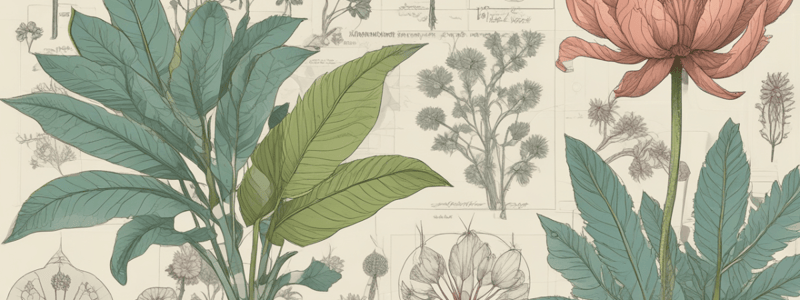Podcast
Questions and Answers
What is the primary function of the internode in a typical stem?
What is the primary function of the internode in a typical stem?
- To provide a space for the growth of new nodes (correct)
- To support the weight of the leaves and flowers
- To facilitate the absorption of sunlight by the leaves
- To transport water and nutrients from the root to the leaves
What is the main difference between a vegetative bud and a reproductive bud?
What is the main difference between a vegetative bud and a reproductive bud?
- Vegetative buds are larger than reproductive buds
- Vegetative buds are found on the roots, while reproductive buds are found on the stems
- Vegetative buds develop into leaves, while reproductive buds develop into flowers (correct)
- Vegetative buds are responsible for transporting water, while reproductive buds are responsible for transporting food
What is the role of the xylem in the plant?
What is the role of the xylem in the plant?
- To transport food made in the leaves to other parts of the plant
- To carry water from the roots through the stem and through the veins in the leaves (correct)
- To facilitate the absorption of sunlight by the leaves
- To support the weight of the leaves and flowers
What is the function of the shoot system in a plant?
What is the function of the shoot system in a plant?
What is the role of the phloem in the plant?
What is the role of the phloem in the plant?
What is the terminal bud responsible for in a typical stem?
What is the terminal bud responsible for in a typical stem?
What is the function of the stem in relation to the leaves and flowers?
What is the function of the stem in relation to the leaves and flowers?
What is the purpose of the nodes in a typical stem?
What is the purpose of the nodes in a typical stem?
Flashcards are hidden until you start studying
Study Notes
The Shoot System
- Develops from the plumule after embryo in the seed
- Grows above ground and consists of a stem bearing branches, leaves, flowers, and fruits
Types of Buds
- Vegetative buds: develop into leaves, branches, or other vegetative parts of the plant
- Reproductive or flower buds: develop into flowers or groups of flowers
Typical Stem Structure
- Has leaves at regular intervals (nodes) with buds at the axle of the leaf
- Has a terminal bud at the growing point
- Internodes are the lengths of stem between nodes
- Typically stands erect from the ground
Functions of Stems
- Connects the root system to the leaves and flowers of the shoot system
- Supports all parts of the shoot system, including branches, leaves, buds, flowers, and fruits
- Facilitates absorption of maximum sunlight through leaf arrangement
- Transports water and dissolved minerals and nutrients from roots to leaves
- Transports food (e.g., sugars) made in leaves to other parts of the plant where needed or stored
Transport in the Stem
- Network of tubes (xylem and phloem) transport water, food, and other substances throughout the plant
- Xylem: consists of xylem vessels, responsible for carrying water from roots through stem and veins in leaves
- Phloem: made of sieve tubes, responsible for carrying food made in leaves to other parts of the plant
Studying That Suits You
Use AI to generate personalized quizzes and flashcards to suit your learning preferences.




